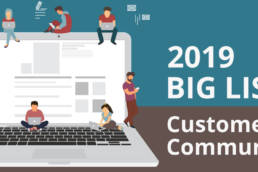By Vanessa DiMauro and Adam Zawel
As social media is growing up, so is executive leadership’s understanding of how it can support or enable an organization’s strategy. My colleague Adam Zawel, community director for Palladium Group’s online community and I wrote an article about the powerful impact social can have in aligning strategy with operations. Palladium was founded by leadership giants Drs. Robert Kaplan and David Norton. The firm helps organizations effectively and sustainably execute their strategies through the use of the Balanced Scorecard, Strategy-Focused Organization, and Strategy Management System frameworks. This article, reprinted from Balanced Scorecard Report (volume 14, number 1), Harvard Business Publishing, was a bold declaration a few years ago, but rings even more true today! It is a long read, but well worth the time.
Social media is useful for more than just social connectivity and entertainment. Political revolutionaries are using social networks to topple regimes (e.g., Egypt, Tunisia), and angry customers can launch social-media campaigns against organizations (e.g., the Dell Hell blog). Organizations can do more than simply react to society’s embrace of these new capabilities. In the hands of a Strategy-Focused Organization, Web 2.0 technologies become “social business” tools and processes, and enable collaboration among employees, partners, and customers. In this article, we focus on the significant benefits that leading organizations are realizing from the integration of social business processes with strategy management frameworks. In particular, we learn how social businesses have tackled some of the perennial challenges of implementing the Kaplan-Norton Management System, including building effective strategy maps, achieving alignment, and gaining the Execution Premium. We use the term “Social” to denote the class of new and emerging tools that enable new forms of communication and collaboration.
Designing the right internal objectives within the process perspective of the Balanced Scorecard, leading to market success in the customer perspective, is a key challenge. In this article, we learn from SAP how the use of an online community with customers and partners can improve the feedback loop on product innovation and help close the gap between internal processes and external customer objectives.
In large organizations, even when a Balanced Scorecard has been rolled out properly, silo mentalities and communication breakdowns can also represent significant obstacles. Alignment is a significant challenge facing many organizations. We learn from New Zealand Post how to structure conversations in online employee communities to communicate strategic objectives and overcome impediments to alignment.
Technology, when used properly, can support the strategic objectives of an organization. Infosys, as part of its Strategy Surround initiative, integrated Social tools with its all-encompassing change process. Social has become an integral part of its efforts to achieve superior economic returns from better strategy execution (the Execution Premium).
Social for Better Strategy Maps
Until recently, most organizations believed that Social was primarily a marketing tool to be used by “millennial” staff to drive traffic to webinars and serve other marketing purposes. However, a number of organizations have begun integrating social business processes into the value chain in a more strategic way.
Social can enable strategy execution by facilitating communications and information exchange with customers and partners. From accelerating research and development efforts to deepening product adoption and customer retention efforts in a more dynamic 24/7 environment, leading organizations are now using Social business processes to support and accelerate their strategy execution programs.
Social business processes sit at the collaborative intersection of business needs and customer desires. This intersection goes well beyond social-media marketing and gets at the heart of the core processes that are integral to an organization’s strategic success. For Social business to be successful, it must solve a real business problem or make a business process easier using the online channel.
Case Study: SAP
SAP is a software system used to enable financial, manufacturing, distribution, and other critical operations. Based in Walldorf, Germany, SAP is a $17 billion company. The company’s technology has long been complex. Therefore, the goal of helping prospective and current customers understand what it is, how to realize its potential, and how to adapt it internally has fueled considerable marketing, R&D, and service investment over the last 20 years.
One SAP executive board member, Shai Agassi, believed that SAP could sell its products more efficiently if customers, business partners, and SAP itself could teach one another about their experiences with the system. That kind of education typically would happen (and did) at company customer events such as Sapphire. But Agassi wanted such experience sharing to happen all the time.
In 2003, the company began building its online customer community (the SAP Community Network or SCN). Today, the firm has five separate online communities under the SCN umbrella: for software developers, business process experts, universities, customers of its Business Objects products, and partners. SAP’s online customer communities have more than 2 million members from over 150 countries. New community members sign up at a rate of more than 30,000 per month. All told, community members see 6,000+ messages posted in the various communities every day, and their questions get answered quickly: 17 minutes is the average time before a first reply comes in.
Many SAP customers love having so much expertise about the company’s complex products so readily at hand. “It has allowed us to save a lot of time and resources and . . . to get a deliverable solution much faster than we would have otherwise without the community,” says an IT manager at the Walt Disney Company, in a video on the SAP website.
The value to SAP (and its network of business partners) is the opportunity to generate more business. For example, current customers, who more readily understand the value of SAP’s products, are likely to buy more once they have heard new products touted directly by other customers in the online community. Says Mark Yolton, SAP’s senior vice president of the SCN, “Being engaged in community and social media has brought SAP tremendous benefits, including product adoption, market penetration, and so on . . . I know that these communities have brought SAP tremendous financial and non-financial benefits.”
Social for Better Strategic Alignment
One of the more challenging aspects of strategy execution is aligning the strategic vision with staff execution. In more socially active organizational cultures, the internal community has a better chance of embracing the strategy of the organization in actionable ways on a daily basis. The question becomes how to go about creating a socially engaging environment. Often, the message becomes diluted. Staff members don’t always understand the nuances of the vision and often do not have forums for exploring what the strategy means to them. The workforce is often at a loss for finding the best ways to perform work that aligns with the strategic direction. This is where Social can play a starring role as a platform for strategy communication. It offers an opportunity for executives to clearly articulate the vision, not just at staff meetings, but publicly and in an ongoing way using internally facing social-media tools. It also can enable staff to have a voice, share concerns, and raise issues related to strategy execution. By creating a platform for internal knowledge exchange, internal teams can support one another, share ideas and resources, and express misunderstandings and questions in a way that can be addressed in real time.
Case Study: New Zealand Post Group
New Zealand Post Group is a group of businesses that provide communication and business solutions in New Zealand and Australia, including the core mail business in addition to banking and digital communication services. New Zealand Post Group is also a leader in strategy execution. In 2009, Kiwibank, the consumer banking subsidiary of New Zealand Post Group, won the Palladium Balanced Scorecard Hall of Fame for Executing Strategy®.
According to the Strategy Execution Hall of Fame Report 2010: “After it became clear that assigning individual executives to be ‘objective champions’ only perpetuated the silo mentality, Knowles [Kiwibank CEO] created cross-functional theme teams structured around the bank’s four strategic themes: Excellence in Business Processes, Sales and Service Leadership, Sustainable Growth, and Learning and Growth . . . Thanks to these changes, the BSC ultimately became an organization-wide framework for action—a reporting, management, and communication tool embedded throughout every level.”
With 17% of the workforce assigned to these strategic teams, the question emerged, “How can you coordinate the communication and work flows across such a large and newly formed group?” Not surprisingly, Kiwibank, and the parent organization, NZ Post Group, were quick to recognize the opportunity to leverage Social to aid this silo-busting exercise. NZ Post decided to leverage third-party technologies to build communities.
In 2010 and 2011, NZ Post invited employees to join two community platforms:
- Using intranet collaboration technology, the company launched a private community open to all employees to discuss issues from social to business. All employees have been encouraged to join.
- Using private group functionality within their Social platform, the company launched a collaboration space for members of the extended strategy execution team. The purpose is specifically to overcome strategic alignment roadblocks and mobilize senior and middle management.
According to Craig Holloway, head of Strategy Execution at Kiwibank: “We are finding the NZ Post Group [Social platform] to be a powerful channel for strategy communication and an effective platform for discussing and overcoming obstacles in strategy execution. This is the first time we have really been able to make strategic connections across our businesses.”
Use Social to Achieve the Execution Premium
Organizations that succeed in this new environment are able to leverage information and relationships gathered through the Social channel and apply them throughout the organization’s value chain. Social can be used to solve specific problems in the strategy execution process, such as tightening the customer feedback loop or facilitating internal alignment. Social, however, can be applied even more broadly to help organizations execute strategy.
Case Study: Infosys
Infosys is a very successful software and services company with more than 100,000 employees. It holistically incorporates Social into its strategy execution process. By using Social as part of its strategy development and communications approach, the company has changed its culture by including more people, especially younger employees, in the strategy development and execution process. Younger employees are typically more comfortable with Social business processes, as they have been educated in a more collaborative learning environment. This broader inclusiveness—engaging younger employees in strategic discussions—was itself a strategic goal at Infosys.
Infosys wanted to “change the rhythm” of work. It didn’t want to “prepare the same code and catch the same bus,” says Sanjay Purohit, vice president and head of Corporate Planning and Business Assurance. To accelerate the company’s strategy execution program (called “Strategy in Action Planning ” or STRAP), Infosys developed “STRAP Surround.” STRAP Surround, which organization’s value chain. Social can be used to solve specific problems in the strategy execution process, such as tightening the customer feedback loop or facilitating internal alignment. Social, however, can be applied even more broadly to help organizations execute strategy. began in 2010 includes a Social platform with blogs and discussion forums, and a range of physical activities (games, cafeteria information, and various forms of interaction) that engage employees. Both the Social and physical components of STRAP Surround are intended to increase awareness of the strategy and improve the company’s performance. Infosys learned that engagement in any messaging or social platform must be associated with offline physical activity. “Life has to change,” says Purohit. The expectation that “people will come and talk about strategy, and things will change is a dream. People have to interact in the physical world for real meaningful change to happen.”
For Infosys, Social is no longer an experiment. Infosys learned from two previous initiatives that Social should not be treated as a stand-alone experiment, but rather must become an integral part of the strategy execution program. Within the STRAP Surround program, the Social channel was especially effective in bringing the discussion to the enormous workforce, including thousands of employees who were joining the company each year. Infosys developed an in-house version of YouTube. (This is a technology company after all, so it enjoys building its own tools.) The video channel enabled chief executives to share their views and get everyone on the same page.
But the true power of Social is in the opportunity for interactivity. Infosys wanted executives to preach, and employees, especially young employees, to respond and participate. The executives, in turn, had to react to this input from the workforce. In a culture that typically respected older employees, Social became a channel in which the young felt empowered and welcomed to participate. The Social medium became the democratizing force that Infosys wanted it to be.
In one particularly successful example of the use of Social with other communication channels, tens of thousands of ideas were shared online after 46,000 employees participated in a variety of live events related to a strategy execution topic. Infosys found that employees related better and participated with more specific answers once the dialogue was structured and moderated. Social facilitators found it useful to encourage employees to respond online to specific questions related to strategic themes such as technologies for future growth, asset efficiency, digital consumer, pervasive computing, and healthcare.
To keep the momentum flowing after the initial input from employees, discussion moderators individually thanked contributors for their suggestions. Each comment was forwarded to a theme owner for further development. As an enticement and reward for particularly passionate and useful suggestions, theme owners chose some employees to become members of their theme teams. Keeping the spirit of the online collaboration, these theme teams continue to collaborate in sub-communities online.
Infosys says it is “just getting started” and is now sharing its experiences with Social with its strategic partners. This is not surprising, since Infosys is a leader in sharing and integrating many of its own processes with partners.
Lessons Learned
Effective Social business approaches can connect people, processes, and technologies in ways that strengthen an organization’s competitive position and increase its brand value with customers, employees, shareholders, partners, and other stakeholders. Here are four wins that Social can deliver:
Accelerate innovation of products and services. Opportunities exist for companies to engage with customers via social media to test concepts, elicit feedback, and validate ideas through “collaborative influence.” This is a powerful way to capture insights that can improve existing products or services and identify needs that can expand business opportunities. This move to Social, or “collaborative influence,” requires a shift in sales, marketing, and development philosophy for most companies.
Strengthen customer loyalty. Social business provides the opportunity to strengthen customer loyalty. For example, organizations that use online communities now have an opportunity to open a dialogue at any time in the customer lifecycle—not just at the point of sale—to find out what customers like and don’t like about a product or service. Nothing is more dangerous to an organization’s brand or product than dissatisfied customers who, today, can activate a global voice. Yet many organizations may not be aware of customer issues until they have incurred significant reputational damage or a decline in revenue
Improve strategic alignment and increase employee productivity. Research conducted by The Society for New Communications Research (www.sncr.org/research) has found that many professionals are collaborating more outside their organizations than within, a result of social media. This is a significant issue for many companies and executives, who may not fully understand or appreciate the value derived through adoption of social-media tools and approaches for internal use.
Attract and retain star staff. The future of business lies in the hands of today’s millennial generation. The expectation of pervasive digital connections means they have a distinct outlook on collaboration, and enterprises must accommodate this desire to attract and retain them.
As the political revolutions that leverage Social show us, Social is powerful. Social gains power when online discussions lead to “engagement” in the street. Infosys and other leading organizations are discovering the same dynamic in the business environment. Social leads to and accelerates activities that are taking place offline in the real world. It can be the glue between your company and its customers, a way of breaking through barriers to allow alignment to happen, and an accelerator for transformation throughout the organization.
Reprinted from Balanced Scorecard Report, volume 14, number 1, Harvard Business Publishing
Vanessa DiMauro
Internationally recognized independent thought leader on social business strategy and operations with a specialty in online community. I help organizations drive top line growth through innovative digital strategy design and thoughtful execution. I have successfully led 60+ strategic social business initiatives for the world's most influential organizations over my 20 years as a social business executive and serve on a number of boards. My award-winning track-record is fueled by passion, experience and research.
My work has been covered by leading publications such as the New York Times, the Wall Street Journal and CIO Magazine and was recently named a Social Marketing Master by Forbes. As a former Executive in Residence at Babson College, Olin School of Management, I am an engaging and informational educator and keynote speaker.
Related Posts
February 8, 2017
The Business Impact of Online Communities: New Study and Framework
Communities generate revenue, save money and advance competitive advantage.…
December 14, 2016
7 Digital Marketing Predictions for 2017
Predictions for digital transformation in 2017


